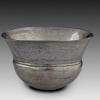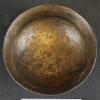"Achaemenid Bowl" from Deve Hüyük (B)
Commentary
"Achaemenid bowl" in bronze from Deve Hüyük. Ashmolean 1913.620, 133.6g; P. R. S. Moorey, Cemeteries of the first millennium B.C., at Deve Hüyük (1980) cat. 113.
The “Achaemenid bowl” is a deep drinking-vessel with a rounded base and an everted rim flaring outwards from a carination. The basic shape is already found in seventh-century Neo-Assyrian contexts, but in the late sixth and fifth century BC it becomes one of the most widespread and distinctive Achaemenid bowl-types, found in various materials (gold, silver, bronze, clay, glass) throughout the empire. Bowls of this type (in slightly varying shapes) are carried by members of four separate delegations on the Persepolis Apadana reliefs: G. Walser, Die Völkerschaften auf den Reliefs von Persepolis (1966), Tafel 43 (Delegation V, Babylonians); Tafel 51 (Delegation VIII, Cilicians); Tafel 59 (Delegation XII, Lydians); Tafel 65 (Delegation XV, Bactrians, with chased decoration).
The distinctive shape (with a “wobbly” bottom and no handles) reflects a characteristic manner of holding the bowl: as is clear from Achaemenid-period glyptic and relief sculpture, bowls of this kind were balanced precariously on three fingers by the drinker. The Deve Hüyük assemblage includes several examples in bronze, of which two are shown here; this page also includes an example in silver from the British Museum.
On the “Achaemenid bowl”, see in general E. Dusinberre, ‘Satrapal Sardis: Achaemenid bowls in an Achaemenid capital’, AJA 103/1 (1999), 73-102; E. Dusinberre, Empire, Authority and Autonomy in Achaemenid Anatolia (2013), 128-140, with extensive bibliography. For the “three-finger balancing act”, see M.C. Miller, ‘Manners makyth man: diacritical drinking in Achaemenid Anatolia’, in E. Gruen (ed), Cultural Identity in the Ancient Mediterranean (2011), 97-134.


